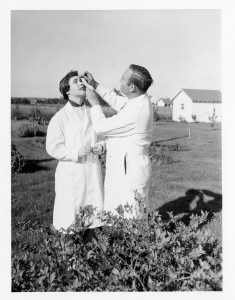Medicinal garden gives way to remote dispensing
Former College of Pharmacy faculty members Bernie Hietbrink and Harold Bailey can remember when the mortar and pestle were actual lab tools rather than just a symbol of the profession.
The mortar and pestle date back to 1,500 years before Christ. The College of Pharmacy hasn’t been around that long, but pharmacy instruction has been a part of State since 1887, when the Board of Regents authorized a pharmacy course to be taught.
The first students were enrolled in 1889, just five years after the first student started at the college.
In 1890, the first group of seven graduates received certificates of completion for the two-year course. Given that there were less than 200 total students at the school in the 19th century’s last decade, the number of pharmacy students graduating was surprisingly high.
In the following years, graduation numbers hit four in 1891, including the first female; seven in 1892, with two females; eight in 1893; and in 1894 there were 11, a mark that wouldn’t be reached again until 1921.
Graduation classes remained in the single digits or slightly above until the late 1930s.
Pharmaceutical garden
When Hietbrink graduated from State in 1958, he was one of 60 in his pharmacy class. Pharmacy education wasn’t primitive in those days —it’s not like the Corsica native was searching the woods for a mystical plant to grind into a healing potion. But the Kenneth Redman’s pharmaceutical garden was very much a part of the curriculum.
Bailey, who like Redman, joined the faculty in 1951, says, “The reason for the garden was so the students could see the drugs of plant origin in their natural environment.â€
In their classroom in the Administration Building, students would walk from microscope to microscope identifying plants.
In the pharmaceutical garden, which was north of the Agronomy Seed House at Medary Avenue and North Campus Drive, students were assigned a plot. “Students had to water and weed the plants. They had to make sure they were growing. That was one of the criteria for passing the course,†Hietbrink recalls.
Harvesting was done by Professor Redman, and students didn’t extract anything from the plant, Hietbrink says.
Classroom compounding
Seniors in that era did do a lot of compounding, carefully measuring chemicals, grinding them in a mortar, and packaging the product. “It was fairly common back in those days – you’d actually manufacture the prescription in your pharmacy,†Hietbrink says.
Glass jars of pharmaceutical chemicals no longer run the length of the laboratory tables.
Labs in the state-of-the-art Avera Health and Science Center bear as much resemblance to the past as the two-year-old facility does to the 99-year-old Administration Building.
Drug chemistry is still taught, but the mortar and pestle are in the pharmacy museum.
Students are taught in the pharmaceutical sciences and pharmaceutical skills laboratories, each of which can hold 30 students.
New building for new generation
One of the most striking examples of the center’s high-tech nature is telepharmacy simulation capability in the practice labs. Defined as remote dispensing, patient counseling can be simulated between a pharmacist in one area of the state and a technician with a patient at a remote site on a video link.
In the simulation, a camera can zoom in on a tablet or capsule to ensure proper identification and label requirements.
Considering all the technological gadgets available to today’s students, the Avera center fits right in with their lifestyle, says Dennis Hedge, who became the college’s 12th dean in 2008.
Dave Graves






